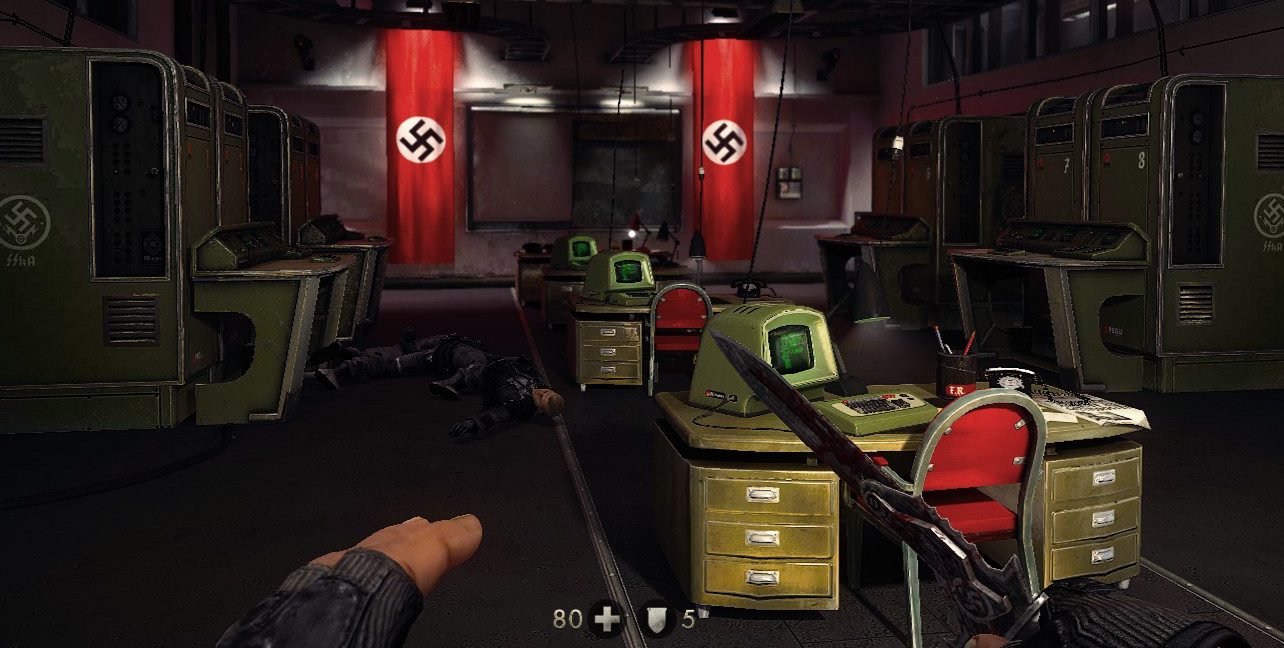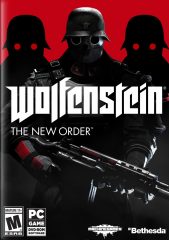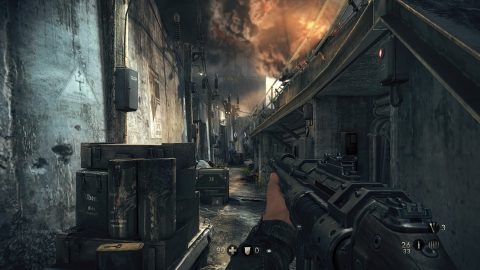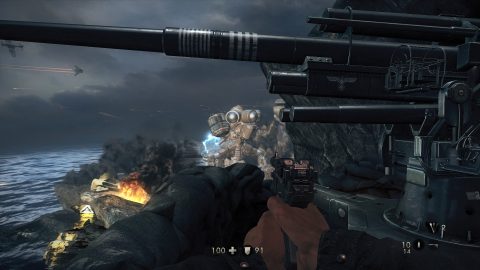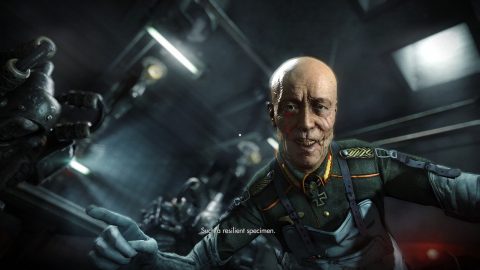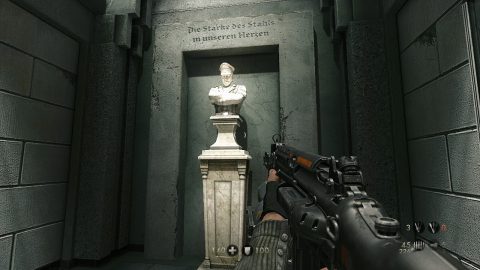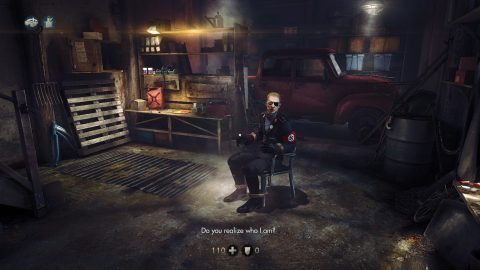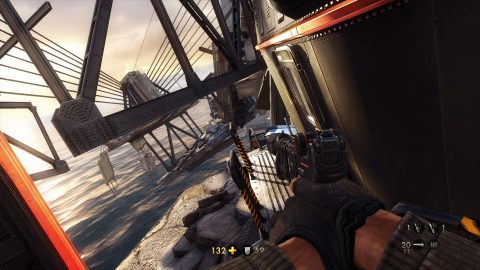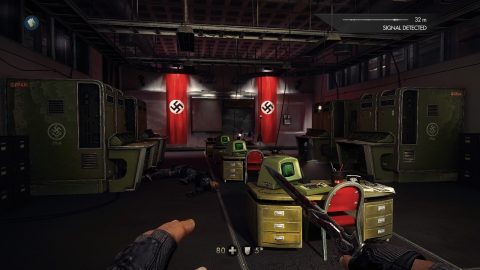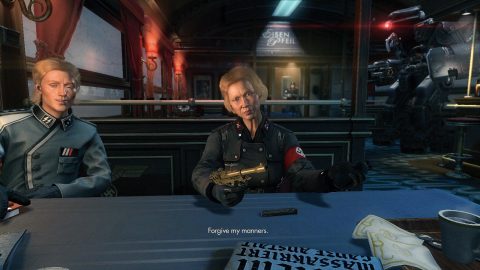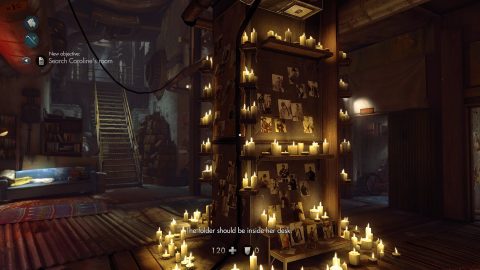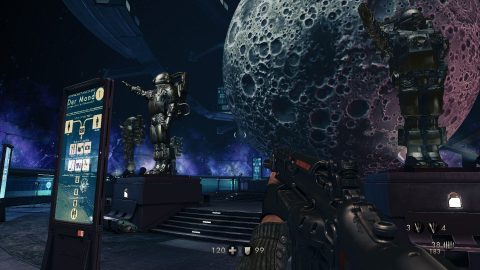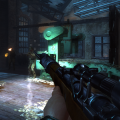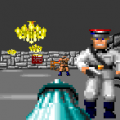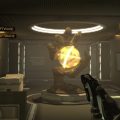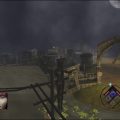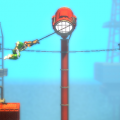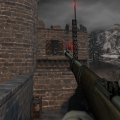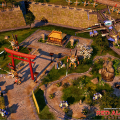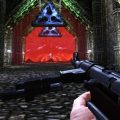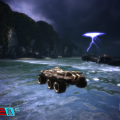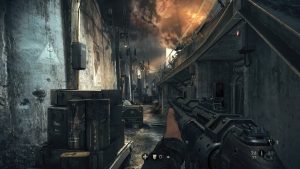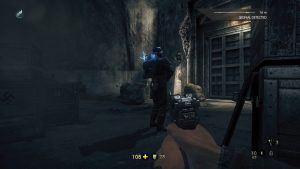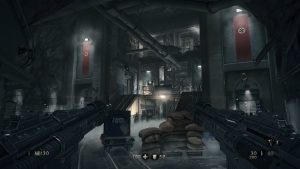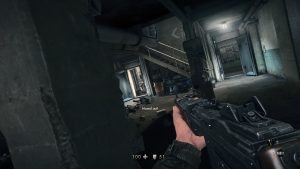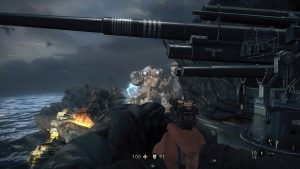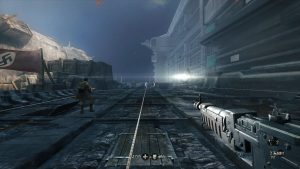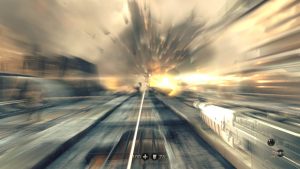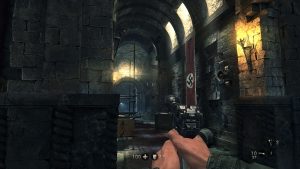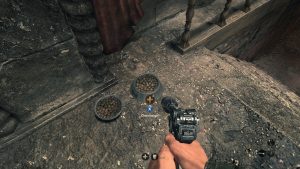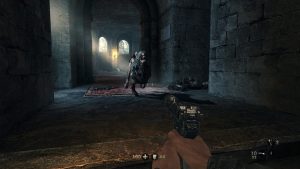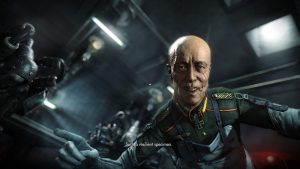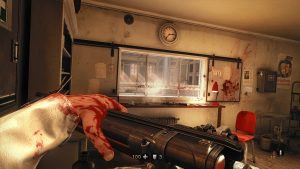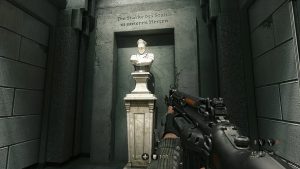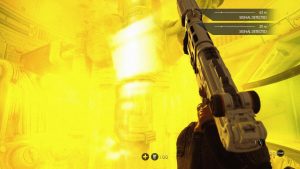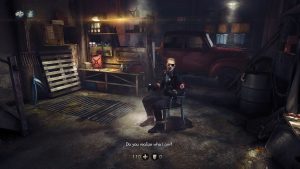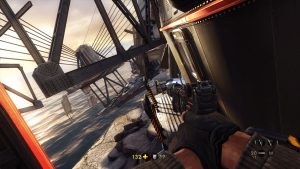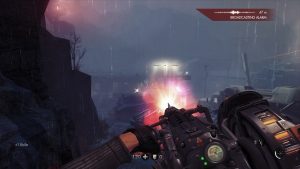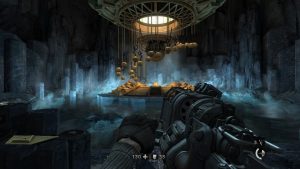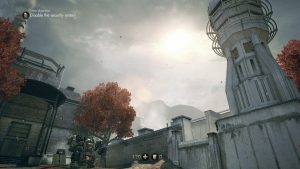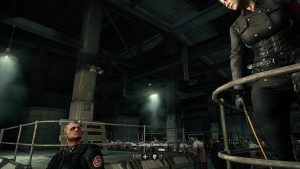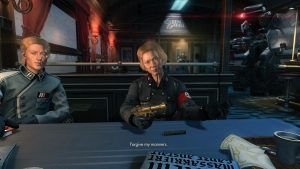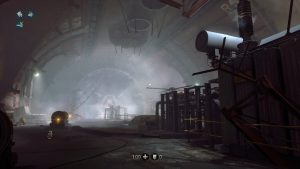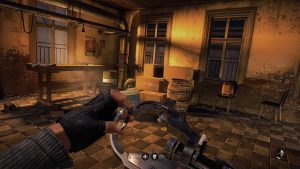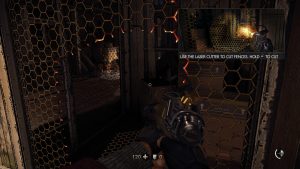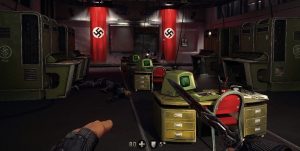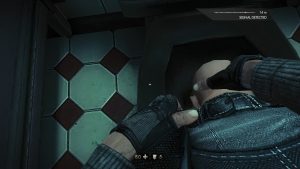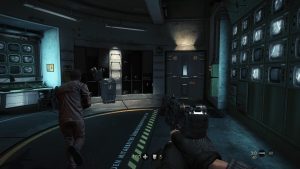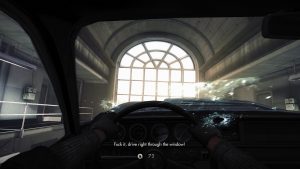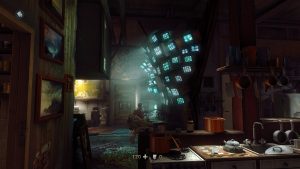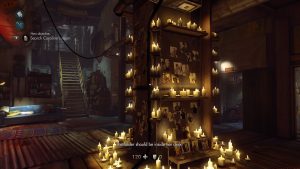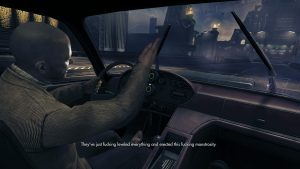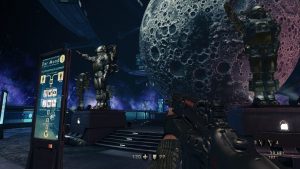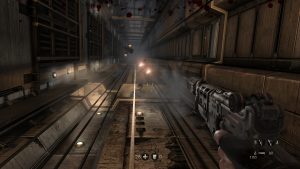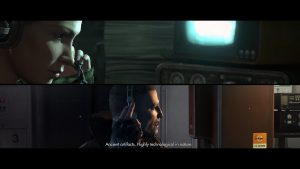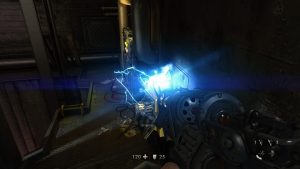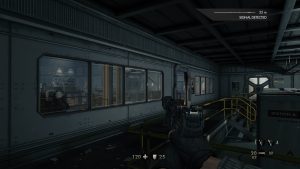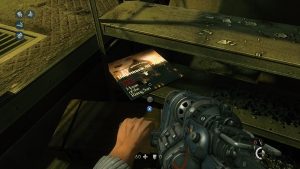When 2009’s Wolfenstein sequel failed to capture the sales numbers Activision had expected, things looked grim for the Wolfenstein fan base, and only looked worse when id Software announced that they were being bought by Bethesda Softworks, the publishers of the Elder Scrolls series, among other things. The gaming public was worried; many id Software titles were suddenly delisted from online storefronts, and many were worried that the next Doom game (then unannounced, but heavily rumored) would wind up being a terribly bug-ridden open-world game. But almost as soon as they disappeared, id Software’s games reappeared on Steam, with little changed but the publisher tags. Then, Bethesda announced a brand new Wolfenstein sequel in development by MachineGames, comprised of many key staff members from Starbreeze Studios that had left after the release of Chronicles of Riddick: Assault on Dark Athena. In early 2014, it finally hit shelves, after much hype and doubt.
Wolfenstein: The New Order yet again casts the player as Captain William J. Blazkowicz, this time in charge of a huge squad of Allied solders in the year 1946. The second World War continues to rage on, with Nazi Germany having got themselves even more fearsomely powerful weapons than before. From robot Panzerhunds, to jet aircraft, to a towering, stomping monstrosity equipped with a massive Tesla cannon, the Nazis clearly have the edge against the woefully under-equipped Allies. After Blazkowicz and company crash-land right in front of their destination, the Allies are tasked with one important task: eliminate General Wilhelm “Deathshead” Strasse, or lose the War.
For one entire mission, things go quite swimmingly. Blazkowicz’s squad successfully penetrates the compound, until they accidentally land themselves inside Strasse’s laboratory, and things quickly go south. As what’s left of the squad makes their daring escape from the compound, having failed to kill Deathshead, Blazkowicz is struck in the back of the head by flying shrapnel and falls into the freezing waters at the foot of the compound. He is presumed dead by his squad, but in actuality picked up by a fishing boat, and is left comatose in a Polish mental hospital for the next fourteen years, where he eventually wakes up just as Nazis have declared that the hospital is no longer of any use to Germany and started killing all of the patients.
The next few levels are desperately fought, as the player will struggle to find useful equipment and come to terms with the terrible future that he has awoken in. It is now 1960, and Germany has not only won the war, but subjugated and dominated most of Europe, if not the entire world. It’s implied that Hitler still lives, though he is never mentioned by name, and our principal villains include not just Deathshead, but also the frighteningly gleeful Frau Engel, as well as the myriad of officers that you will inevitably cross paths with as you struggle against the might of Germany, and eventually reconnect with what’s left of the old resistance.
The time-skip to 1960 has brought with it a wide variety of new weapons and technology that you can steal, from advanced variants on German Army standard weapons, to Tesla grenades, welding torches, and laser weaponry. Sadly, the economy and upgrade system from Raven’s Wolfenstein have been all but cut, with most weapons only ever receiving one upgrade that is found at a specific point in the game. The major exception is the laser cutter that you find early on; while at first, it is only good for cutting holes in wire fences, it receives add-ons to improve its battery life and allow it to be fired like a pistol at guards, and is eventually replaced by the powerful Laserkraftwerk. The LKW winds up receiving even further upgrades, from full-auto capability to reflective shots and a Panzer Dragoon-esque target locking scope. The LKW generally becomes the mainstay of your arsenal, but that’s not to say that the other weapons don’t pull their own weight. Much like Raven’s game before it, The New Order does not limit your weapon inventory. Once you’ve found a weapon, it generally stays with you, though your inventory tends to be cleared out between missions, save for the LKW, a knife, and a mild assortment of ammo for the pistol and assault rifle. But beyond this, you can also dual-wield almost every weapon in the game, even with upgrades like the rocket launcher attached.
In addition to the upgrades to the actual weapons, The New Order has an assortment of perks that can be unlocked, which range from ammo capacity boosts, to silent running, vampirism for stealth kills, and faster run speed while dual-wielding. There is no experience system in the game with which to unlock the perks; rather, they are unlocked by completing specific challenges, like stealth kills with thrown knives. This means that the player is typically rewarded for doing specific things by allowing them to do those things better, and also rewards players who switch up their play style once in a while.
In defiance of modern first-person shooter conventions, The New Order sports an atypical cover system, more reminiscent of shooters from the era of Return to Castle Wolfenstein than the more modern Gears of War-style system. When close to wall edges, aiming down the sights will automatically peek around corners or over chest-high barriers. The point of view never cuts away from Blazkowicz’s eyes during gameplay, and in addition, the “cover” button functions more like a traditional leaning system than a “proper” cover button would. Since the cover/lean button is separate from the Crouch button, this also allows a sort of “low crouch” function, enabling players to peek under obstacles to find things tucked under bunk beds, or to shoot some guy in the ankles.
Further distancing itself from the wide variety of Call of Duty-like military shooters, The New Order also mostly does away with regenerating health and the “bloody screen” effect. The system in use here is more reminiscent of Starbreeze Studios’ games, like Chronicles of Riddick: Escape from Butcher Bay, in that while health does regenerate over time, it takes a while to build up, and only regenerates up to the next multiple of 20. So if you find yourself with only 21 hit points, but manage to not take any damage for the next several seconds, you’ll find it will eventually crawl back up to 40. To build your health back up to its maximum, medical kits – as well as Wolfenstein staples like hot meals, bread, and dog food – can be found lying about. If you have already reached your maximum, you can continue collecting health items to overcharge your hit points past the normal amount, with the caveat that overcharged HP will slowly degenerate, a la Quake‘s Mega Health items, until you’ve stopped at your max. Health and armor upgrades can also be found, in the form of red and blue statues hidden within secrets; which ones you find depend on which timeline you’ve found yourself in.
Which brings us to replayability. The New Order offers two timelines; during the first mission, the player is forced to choose which of his two squadmates to save, between Scottish pilot Fergus Reid, and Private Probst Wyatt III of the US Army. The ramifications of this choice are not immediately obvious, encouraging players to play through the game twice to see the differences. While both the Fergus and Wyatt timelines send the player through the same missions, there are a few changes in the route taken. Saving Fergus enables the player to hot-wire control panels, while saving Wyatt grants you the ability to pick locks. Generally, you’re able to access most of the same areas between the two timelines, but the change in abilities allows you to take a different approach in most levels, as well as find different upgrades, secrets, and collectibles for those willing to explore.
The New Order‘s story and presentation take a very noticeably darker approach than the rest of the series. Blazkowicz now sports a Max Payne-esque inner monologue, and the music has forsaken the Bill Brown-composed orchestration of the last two games in favor of a heavy industrial soundtrack by Mick Gordon, its heavy use of analog distortion being more reminiscent of Trent Reznor’s work on Quake. The game is far less apologetic than its predecessors in presenting the Nazis themselves; it stands heavily in contrast to the original Wolfenstein 3D‘s more cartoony Nazis and even the Indiana Jones-ish ones from Return and its sequel, as the Nazis are depicted as heartless, cruel and downright terrifying, especially Frau Engel, her “lover” Bubi, and most importantly, Deathshead himself. The Nazis of The New Order feel genuinely threatening, dangerous, even psychotic at times. There are moments when Blazkowicz finds himself at the Nazis’ mercy, for one reason or another, where the player may be genuinely convinced that they may not come out intact, or alive. The torture scenes in this game could almost be considered scarier than most games that target horror as a primary genre. Blazkowicz, by comparison, comes off as grim, desperate, world-weary, almost suicidal. “Another kid you murdered,” he remarks at some point, in the not-quite-cliche gravelly voice of a post-2000s video game hero. “Are you keeping count, Deathshead? One of us is going to die today.”
Contrasting Blazkowicz’s pessimism, the members of the underground resistance have a more optimistic outlook to things, despite living…well, underground. The new Kreisau plays host to a few colorful folks, like Max Hass, a simpleton brute who is missing half of his head and only possesses the mental capacity to say his own name; Tekla, an eccentric Russian girl who is obsessed with her mathematical formulas that only appears if you chose Fergus, “J,” a young jive-speaking guitarist (implied to be based on a certain famous rocker) that only appears if you chose Wyatt; and Klaus, a former Nazi patriot who, frustrated with the regime, joined the Kreisau to avenge his dead family. Joining them are either Fergus or Wyatt, depending on which one you saved in the prologue. Fergus is certainly more entertaining, being very Scottish (down to singing pub songs while you mow down hordes of baddies), but he resents that Blazkowicz saved him and not Wyatt. Wyatt, on the other hand, is a little more serious, and more typical of a Call of Duty-like squaddie, constantly barking out things like “Cover me!” and generally not distancing himself from the usual first-person shooter tropes. Lastly, there is Anya Oliwa, the Polish nurse that was the only other survivor of the Nazi attack on the mental asylum towards the beginning of the game. Anya falls into a somewhat typical role in the game, serving as both Blazkowicz’s main love interest and as your main radio contact during missions. That’s not to say that she doesn’t help out from time to time, but there are at least two other first-person shooters that have had radio operators named Anya, including the less-than-serious TimeSplitters: Future Perfect, which somewhat undermines Miss Oliwa’s placement among The New Order‘s cast.
The world presented in the game could be seen as a sort of dystopian future, but not an apocalyptic one like Falloutor Metro 2033, nor an Orwellian nightmare like Nineteen-Eighty-Four or Mirror’s Edge. There are occasional nods to the old axiom, “the more things change, the more they stay the same.” You will find everything from posters depicting man on the moon, to record albums like “Das Blaue U-Boot” and a German-language recording of “House of the Rising Sun,” to newspaper clippings describing the historical events that Blazkowicz missed while he was catatonic in the Polish mental asylum, like America’s surrender to Germany following an atomic bombing. It is almost as scary as the Nazis themselves, though outside of the newspaper clippings and occasional visits to resistance headquarters, you really don’t get much of a sense of what it’s really like to live in the Nazi-controlled 1960s.
On a technical level, The New Order is somewhat hit-and-miss. The game utilizes the id Tech 5 engine, previously seen in id Software’s own RAGE. Back in the day, id Software’s engines represented the bleeding edge of technology, allowing ultra-fast-paced gameplay with beautiful graphics and high performance. id Tech 5 almost feels like a technological misstep, focusing on features that don’t benefit the end-user at all. The much-touted “megatexture” system, while generating environments with extremely high detail without repeated textures or heavy load times, comes with its own major issues, notably terrible texture pop-in (some doors and barriers might even disappear completely on weaker computers, until you’ve been staring at them for long enough) and an absolutely massive file size. The New Order clocks in at just over 40 gigabytes in download size on Steam, with the Xbox 360 and PC retail versions shipping on an unheard-of four DVDs, and the PlayStation 3 disc version requiring an 8 gigabyte hard drive install to even function. The game does look fantastic, when the engine allows it to, but one really ought to question the use of the engine when it only seems to be degrading players’ experiences of the game.
The storyline is a point of contention too. It’s generally well-executed, especially in humanizing Blazkowicz and his allies, and displaying the oppressiveness of the Nazi regime, some twists late in the game – such as the existence of an ancient secret society – feel a little heavy-handed in concept, and the game includes not one, but two sex scenes between Blazkowicz and Anya; neither of them lasts longer than a few seconds, but they feel somewhat out of place in the context of the rest of the game. The game’s ending, though, comes as suddenly as a stick of dynamite in one’s breakfast cereal: unexpected, pointless, and ultimately damaging to the experience. If one is willing not to read too deeply into the symbolism of some of the in-game events, The New Order could still be said to have the most engrossing story to be found in a Wolfenstein game, if not first-person shooters as a whole.
While certainly, the noted absences of certain gameplay features and occasionally hamfisted nature of the story could be seen as detriments to the game, Wolfenstein: The New Order still stands as an excellent title that ought to resonate with series fans, first-person shooter fans, and game players in general. This author wouldn’t dare say that it’d beat a good novel or something like Schindler’s List, but as a video game, The New Order is overwhelmingly worth at least one playthrough, without skipping the cutscenes or glossing over the story, especially since the game mechanics and overall execution are good enough to hold it up past the occasional hiccup in the experience.
